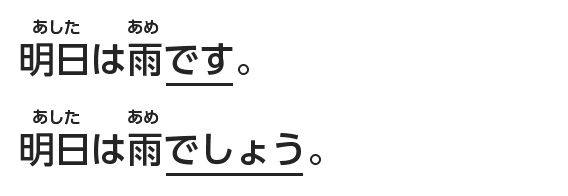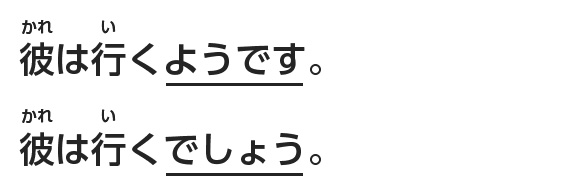Teach Us, Teacher
How to use DESHÔ (Lesson 43)
You use DESHÔ at the end of a sentence, when you talk about a prediction for the future or something uncertain. When you use it in combination with nouns or adjectives, you replace DESU at the end of a sentence by DESHÔ.Let's try and say "it will probably rain tomorrow."
 "Tomorrow" is ASHITA. "Rain" is AME. "It will rain tomorrow" is ASHITA WA AME DESU. If you replace DESU by DESHÔ, you get ASHITA WA AME DESHÔ (It will probably rain tomorrow).
"Tomorrow" is ASHITA. "Rain" is AME. "It will rain tomorrow" is ASHITA WA AME DESU. If you replace DESU by DESHÔ, you get ASHITA WA AME DESHÔ (It will probably rain tomorrow).When you use it in combination with verbs, you change the verbs to the plain forms such as the dictionary form or the NAI-form, and attach DESHÔ to them. Let’s try this with "he will probably go." First, let's consider "he goes or will go." "He" is KARE. "To go" is IKIMASU. So, we say KARE WA IKIMASU. Now, the dictionary form of IKIMASU is IKU. So, "He will probably go" is KARE WA IKU DESHÔ.
In Lesson 25, you learned YÔ DA, a casual form of YÔ DESU. It seems similar to DESHÔ. But what is the difference? Let’s compare the following examples:
KARE WA IKU YÔ DESU is "It seems to me that he will go."
KARE WA IKU DESHÔ is "He will probably go."
 You use YÔ DESU or YÔ DA, when, you think he will go, judging from the circumstances. You use DESHÔ, when you are simply guessing what will probably happen in the future.
You use YÔ DESU or YÔ DA, when, you think he will go, judging from the circumstances. You use DESHÔ, when you are simply guessing what will probably happen in the future.